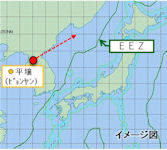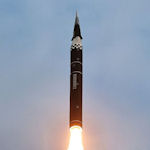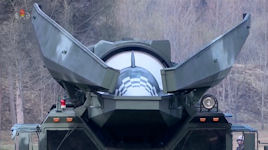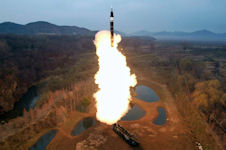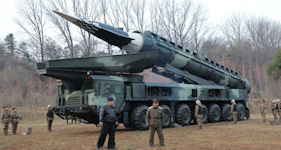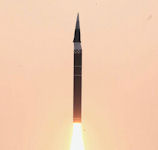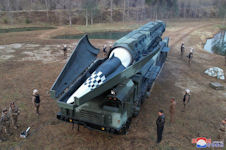Hwasong-16 LRBM
The suspected former HS-16 is officially the HS-17.
 The HS-16 was shown for the first time at the exhibition in October 2021.
North Korea said it tested a new solid-fuel intermediate-range ballistic missile on 14 Janury 2024 fitted with a hypersonic warhead capable of striking Guam or Okinawa in Japan, as it continued efforts to develop more powerful, harder-to-detect weaponry. Detected by neighboring Japan and South Korea, the launch was designed to test the reliability of new multi-stage, high-thrust solid-fuel engines and an intermediate-range hypersonic manoeuvrable controlled warhead, the state-run Korean Central News Agency (KCNA) reported on 15 Janury 2024. KCNA added that the test-firing “never affected the security of any neighbouring country and had nothing to do with the regional situation”.
The HS-16 was shown for the first time at the exhibition in October 2021.
North Korea said it tested a new solid-fuel intermediate-range ballistic missile on 14 Janury 2024 fitted with a hypersonic warhead capable of striking Guam or Okinawa in Japan, as it continued efforts to develop more powerful, harder-to-detect weaponry. Detected by neighboring Japan and South Korea, the launch was designed to test the reliability of new multi-stage, high-thrust solid-fuel engines and an intermediate-range hypersonic manoeuvrable controlled warhead, the state-run Korean Central News Agency (KCNA) reported on 15 Janury 2024. KCNA added that the test-firing “never affected the security of any neighbouring country and had nothing to do with the regional situation”.
The launch came as the North's Foreign Minister Choe Son Hui headed to Moscow, amid concerns in the United States and elsewhere that Pyongyang was selling weapons to Russia for use in Ukraine in return for Russian technological expertise. The North's state media also said her visit was at the invitation of her Russian counterpart, Sergei Lavrov. The two isolated governments have been forging ties, following a rare summit between their leaders last September. The North appears to be supplying military equipment to Russia for use in its war with Ukraine, while Russia was providing technological support for the North's satellite and missile programs.
The missile flew towards the East Sea, Seoul’s Joint Chiefs of Staff said in a statement on 14 Janury 2024, adding that authorities in Seoul, Washington, DC and Tokyo were analysing the specifications. In the meantime, the top nuclear envoys from the three nations held a phone call on Sunday and strongly condemned the launch. They said the latest launch has once again shown that North Korea's illegal provocations are the causes of instability in the region, and warned that the security cooperation between the three countries will only become stronger as the regime continues to engage in more provocations.
The South Korean military assessed that the missile, launched from an area near Pyongyang, appears to have been an intermediate-range ballistic missile that traveled about 1,000 kilometers (600 miles) before landing in the East Sea. It added that it shared information on the missile with the U.S. and Japan, and that it's analyzing further details of the launch.
The Japanese Ministry of Defense stated, in a statement on 14 January 2024, that : “North Korea launched a ballistic missile at 14.53 (8.53 Moscow time) in the northeastern direction. The information is currently being analyzed, but it is believed that the flight altitude of the ballistic missile was more than 50 kilometers, and its flight range was at least 500 kilometers.” According to the statement, “The North Korean missile fell on the eastern coast of the Korean Peninsula in the Sea of Japan, outside Japan’s exclusive economic zone.” The fall of the missile did not cause any damage to Japanese aircraft or ships. The statement indicated that a crisis headquarters had been formed in the Japanese Prime Minister's Office to follow up on the consequences of the launch. The Japanese government filed a protest with North Korea regarding the launch.
North Korea’s last missile test was of a Hwasong-18 solid-fuel intercontinental ballistic missile (ICBM), which it fired into the East Sea on 18 December 2023. It previously tested new solid-fuel engines for an intermediate ballistic missile on November 11 and November 14. Leader Kim Jong Un last week branded Seoul his “principal enemy” and warned he would not hesitate to annihilate South Korea. “The historic time has come at last when we should define as a state most hostile toward the Democratic People’s Republic of Korea the entity called the Republic of Korea [South Korea],” Kim was reported as saying by KCNA.
Analysts said the timing of the latest test was a concern. “This launch is more than just a test as it comes immediately after the Kim regime escalated warlike rhetoric toward South Korea and just before North Korea’s foreign minister travels to Russia,” Leif-Eric Easley, a professor at Ewha University in Seoul said in emailed comments. “Pyongyang’s show of force should be of concern beyond Seoul, as its military cooperation with Moscow adds to the violence in Ukraine, and because it may be more willing to challenge the U.S. and its allies while global attention is fixed on the Middle East.”
In separate KCNA commentary on 15 January 2024, North Korea accused Seoul of escalating tensions in the region with military drills and calls for more armaments by South Korean officials. “Even a little spark can be a catalyst for enormous physical conflicts between the two most hostile countries,” the commentary said. Analysts say Kim’s move to designate South Korea as a separate, enemy state, could potentially help justify the use of nuclear weapons against Seoul in a future war.
Despite its difficult economic situation, Pyongyang conducted a record-breaking series of weapons tests in 2023, including its first solid-fuel ballistic missile, which experts called a major technological breakthrough. It also put its first spy satellite into orbit, after two failed attempts. Analysts say it benefitted from Russian expertise after Kim travelled to Russia’s Vostochny Cosmodrome to meet President Vladimir Putin. Kim detailed a wish list of sophisticated military equipment, including hypersonic weapons multi-warhead missiles, spy satellites, solid-fuel long-range missiles and submarine-launched nuclear missiles in 2021.
Solid-fuel missiles can be launched more quickly and are easier to move and conceal, which theoretically makes them harder to detect. Hypersonic weapons are designed to fly at speeds in excess of Mach 5, or five times the speed of sound. If perfected, such systems could potentially pose a challenge to regional missile defence systems because of their speed and manoeuvrability.
The first launch was on 04 January 2022. This short missile, derived from the HS-12, has a simple RV with stabilizing fins. The missile achieves a higher velocity in climb thanks to the approximately one-third lower amount of fuel, but has a shorter burning time and also a shorter range.
North Korea conducted an apparent missile test, South Korea and Japan reported, just days after an end-of-year speech in which leader Kim Jong Un focused on domestic economic woes rather than military advancements. North Korea fired at least one projectile toward the sea off its east coast early Wednesday, South Korea's Joint Chiefs of Staff said in a statement. Japan's coast guard said the launch may have involved a ballistic missile. No further details were available, including how many missiles were launched, how far they went or where they landed.
Japanese Defense Chief Nobuo Kishi has since indicated that the projectile flew over a standard trajectory for roughly 500 kilometers. He further stated there were no reports of damages caused by the launch. It was the first missile test by the Democratic People's Republic of Korea (DPRK) since October, when it fired off a submarine-launched ballistic missile (SLBM).
Despite the latest missile test, Moon said he would not give up hope for dialog with North Korea, according to his office. "We should not give up the hope for dialogue in order to fundamentally overcome this situation," he said. "If both Koreas work together and build trust, peace would be achieved one day."
According to Rodong Sinmun, the official paper of the ruling Workers Party of Korea, the test accelerated the task of "modernizing the national strategic force." The paper says the test verified the ability of the fuel ampoule system to operate "under winter weather conditions" and demonstrated an increased ability to stabilize and control the hypersonic glide vehicle, "which combined a multi-stage gliding jump flight and a strong lateral movement." The glide vehicle is boosted by a rocket engine during the initial stage of a hypersonic weapon's launch before detaching and gliding toward its target, adopting an unpredictable flight path to avoid interception.
"In the test launch, the [Academy of Defense Science] reconfirmed the flight control and stability of the missile in the active-flight stage and assessed the performance of the new lateral movement technique applied to the detached hypersonic gliding warhead," the Sinmun said. "Having detached after its launch, the missile made a 120 km lateral movement in the flight distance of the hypersonic gliding warhead from the initial launch azimuth to the target azimuth and precisely hit the target 700 km away," it added.
The January 2022 launch was the DPRK's second test of a hypersonic weapon. The first, an unrelated glide system, was held in September, timed to coincide with the socialist nation's envoy to the United Nations taking the podium at the General Assembly in New York to speak about the DPRK's right to self-defense but willingness to talk peace, which has eluded the peninsula for 72 years. That other weapon is named Hwasong-8.
The 15 January 2024 DPRK hypersonic glide vehicle test on the Hwasong-16 appears to be a rather larger system than the first test. Lately the DPRK has been showing off inventories of multiple rockets, refuting claims of onesies and twosies. Surely this must be true for some variants, but just as surely some of the blooming buzzing profusion of their missiles were dead ends built in only small numbers. The “intermediate-range hypersonic maneuverable controlled warhead” test was carried out to verify its “gliding and maneuvering characteristics” and the “reliability of newly developed multi-stage high-thrust solid-fuel engines,” the Korean Central News Agency (KCNA) reported.
The launch was aimed at testing the reliability of new multi-stage, high-thrust solid-fuel engines and an intermediate-range hypersonic manoeuvrable controlled warhead, according to KCNA, which said the test did not pose a security threat to neighboring countries. South Korea in a statement criticised the launch as a violation of United Nations Security Council resolutions and said direct provocations by the North would be met with its "overwhelming response". South Korea’s Joint Chiefs of Staff said the missile flew about 1,000 kilometers (620 miles) before landing in the waters between the Korean Peninsula and Japan.
Hwasong-16B
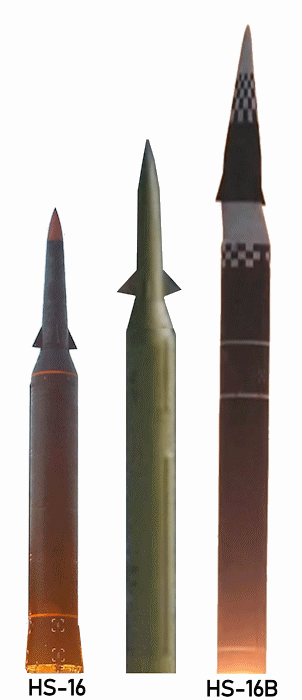 On 02 April 2024 North Korea claimed a successful test of Hwasong-16B, described as "a new-type intermediate-range solid-fueled ballistic missile loaded with newly-developed hypersonic gliding warhead". The IRBM was cold-launched from a canister aboard a new seven-axle TEL vehicle. The Japanese MoD reported "At around 6:52 AM today, North Korea launched at least one ballistic missile from the west coast of North Korea toward the northeast. The details are currently being analyzed, but it is estimated that it fell in the Sea of Japan east of the Korean Peninsula, outside Japan's EEZ."
On 02 April 2024 North Korea claimed a successful test of Hwasong-16B, described as "a new-type intermediate-range solid-fueled ballistic missile loaded with newly-developed hypersonic gliding warhead". The IRBM was cold-launched from a canister aboard a new seven-axle TEL vehicle. The Japanese MoD reported "At around 6:52 AM today, North Korea launched at least one ballistic missile from the west coast of North Korea toward the northeast. The details are currently being analyzed, but it is estimated that it fell in the Sea of Japan east of the Korean Peninsula, outside Japan's EEZ."
The missile was substantially longer that earlier iteratiosn of the HS-16, consistent with the larger reentry vehicle. Kim lauded it as a strategic weapon that demonstrates the "absolute superiority" of North Korea's defense technology, saying that all of the country’s tactical, operational, and strategic missiles are now solid-fuel and nuclear capable. During the flight, after separation from the missile, the warhead performed vertical maneuvers. The apogee height during the first "jump" was 101.1 km, and during the second - 72.3 km.
North Korea claimed that it successfully test-fired a new type of solid-fueled hypersonic missile. The regime's state-run media said Wednesday that the first launch of the Hwasong-16 intermediate-range missile was carried out the day before. It said the test was overseen by leader Kim Jong-un, who announced the regime has now turned all of its missiles into solid-fueled, nuclear-capable ones with independently controlled warheads. The North said the latest test was aimed at verifying the weapon system's reliability, and that the missile traveled around a thousand kilometers.
The report in the state-run Korean Central News Agency (KCNA) came a day after South Korea and Japan detected the launch of a missile from North Korea towards the east. KCNA shared photos of leader Kim Jong Un on site near the weapon, the Hwasong-16B, as well as with his military commanders, less than two weeks after he supervised a solid-fuel engine test for an IRBM. Kim lauded the weapon as a demonstration of the “absolute superiority” of North Korea’s defence technology. Pyongyang had developed nuclear-capable, solid-fuel systems for “all the tactical, operational and strategic missiles with various ranges”, he added, according to KCNA.
The North Korean leader promised to further develop the country’s arsenal to counter his “enemies”, a reference to Japan, South Korea and the United States. KCNA said the Hwasong-16B flew for about 1,000km (620 miles), reaching a peak altitude of 101km (62 miles). Seoul’s military said it was airborne for about 600km (370 miles) before splashing down in the sea between South Korea and Japan.
North Korea was focused on developing more sophisticated solid-fuel weapons because they are easier to conceal and move, and can be launched more quickly. Liquid-propelled weapons need to be fuelled before launch and cannot stay fuelled for long periods of time. Hypersonic weapons, meanwhile, are designed to exceed five times the speed of sound and can also be maneouvred in flight. North Korea previously said it tested a hypersonic IRBM in January. The hypersonic IRBM launched in January appeared to feature a conical maneuverable reentry vehicle (MARV), while the one tested Tuesday features a hypersonic glide vehicle (HGV).
Analysts say such weapons, if perfected, would be potentially capable of reaching remote US targets in the Pacific, including the island of Guam. “North Korea, in declaring that it has fully accomplished the nuclear weaponisation of its missiles, also emphasised its commitment to arm its hypersonic missiles with nuclear weapons,” Chang Young-keun, a missile expert at South Korea’s Research Institute for National Strategy, told the Associated Press news agency. “North Korea’s development of hypersonic IRBMs targets Guam, which hosts US military bases, and even Alaska.”
Rodong Sinmun reported that the test “was aimed at confirming the designed technical specifications of the new-type intermediate-range hypersonic missile as a whole and verifying the reliability of this weapon system.” The launch “verified the characteristics of gliding-skip flight orbit and cross-range maneuvering capability of the hypersonic glide vehicle (warhead) while confining its range to less than 1,000 kilometers, in consideration of safety.” The DPRK Missile Administration decided to “forcibly control the speed and altitude by means of delaying the start-up of the second-stage engine and rapidly changing the flight orbit in the active region,” according to the report.
ROK President Yoon said this latest launch is aimed at shaking South Korea ahead of the general election, adding that it will only bring the country closer together. "Provocations like this only unite the hearts of our people more tightly. We hope that our military will maintain a full security posture in preparation for further provocations by North Korea."
The South Korean military assessed that the missile traveled only about 600 kilometers, before falling into the East Sea. It dismissed speculation on Wednesday that the country's radar systems were unable to fully track the missile, saying the North's claims were "exaggerated." The military said the latest test appears to have been an early development stage one, although it admitted that Pyongyang appeared to have made some technological progress. The Joint Chiefs of Staff said it would take some time for the North to deploy hypersonic missiles that can maneuver perfectly.
A South Korean missile expert said their speed and unpredictable flight paths make them very difficult to track and intercept. "Since North Korea pledged to develop hypersonic missiles in 2021, it has gone through a lot of trial and error. For the first time, North Korea has tested a specific form of hypersonic missile that it's been aiming for. It will likely test-fire the missile two to three more times." He added that the North is likely to start developing hypersonic ICBMs, which are longer-range missiles that are aimed at targeting the U.S. mainland.
Retired Lt. Gen. Chun In-bum, a former commander of the South Korean special operations command, said the latest development calls for more effective missile defense capabilities. "... the North Koreans have rockets that are now solid-fuel based, which means they can be launched anywhere and at any time. It adds the element of surprise to its weapons system, as well as mobility... And with the speed of the rockets, it makes it difficult for us to shoot down these missiles. But the real challenge is the maneuverability of these warheads, which will make them more difficult to shoot down."
The military expert said that there are new missile defense technologies in the development stage that will be able to surmount the evolving nuclear threats from the North. He also called for the boosting of active defense capabilities, saying that in the event of a contingency the most effective way to counter hypersonic weapons is to destroy them before they are launched.
Developing hypersonic weapons was one of the regime's five main tasks under a five-year military plan announced at the start of 2021.
ROK military officials said the 02 April 2024 launch appeared to be an upgrade from January's test-firing, as they spotted enhanced missile capabilities with the newly tested solid fuel engine. "The latest launch is believed to be related to the solid-fuel engine ground test that North Korea publicly revealed in March."
Maneuvering RV (MRV)
In the continuing race between the designers of attack missiles and the designers of countermeasures, missiles are improved by becoming more sophisticated. Among such improvements is the introduction of missile maneuvers during exo-atmospheric and endo-atmospheric flight. Such maneuvers may defeat ballistic missile engagement systems which are predicated on ballistic motion of the target. One option for countering U.S. missile defenses would be the development of a maneuvering reentry vehicle (MARV). The maneuvering capability could be used to complicate hit-to-kill or conventional warhead ballistic missile defense systems.
One type of atmospheric re-entry vehicle (RV) is a ballistic RV which, after an initial launch and boost phase, follows a substantially purely ballistic path after separation from a launch vehicle. That is, the position of the RV target can be predetermined if the velocity of the RV and if the boost phase trajectory is known. One disadvantage associated with a purely ballistic RV is that, inasmuch as the target position can be predetermined after separation, interception of the RV can be readily accomplished.
To improve survivability, it is thus desirable to provide an improved type of RV which is an evader maneuvering RV (EMRV) capable of executing in-flight evasive maneuvering operations after re-entry. Inasmuch as the trajectory of the EMRV after re-entry would not be required to be purely ballistic, the position of the EMRV's target would remain uncertain until the completion of the maneuverers. Thus, interception of the EMRV would be made difficult to accomplish.
Such an EMRV would include a suitable maneuvering capability and also a three-axes navigation system for guidance. Preferably, the navigation system would employ a strap-down inertial navigator having ring laser gyroscopes (RLGs) which are inherently more rugged and capable of executing high-G maneuvers than are conventional mechanical gyroscopes. One purpose of the navigation system is to maintain EMRV position information during evasive maneuvering such that the EMRV can be guided to a target at the completion of maneuvers. The EMRV would also typically include an altitude measuring system, such as a radar altimeter, in order to fuse the EMRV's ordinance at a predetermined altitude.
Following the boost phase, and during a coast phase, an EMRV is spin stabilized. As can be appreciated, even with the greatly improved scale factor stability which is obtainable with modern RLGs, a high-G EMRV maneuvering phase will result in a significant EMRV position error at the completion of maneuvering due to the loss of altitude reference during the spin stabilized coast phase. If uncorrected, the computed position of the target relative to the EMRV will also be in error. Known techniques of compensating for the altitude reference error prior to high-G maneuver, or alternatively for the position error following the high-G maneuver are generally inappropriate in an EMRV due to at least the increased weight and complexity associated with such correction systems.
Generally, the hypersonic reentry vehicle enters the atmosphere of the Earth at an altitude of about 100~120 km. The full flight trajectory ranges from the high orbital reentry interface to the terminal area at 20~30 km in altitude. The reference trajectory is typically generated offline and preloaded on the hypersonic glide vehicle before launching. It is often required to correct the reentry trajectory for tracking errors during the reentry flight and even to replan a reference trajectory onboard for reaching a new target or aborting. It is a challenging task to optimize a reference trajectory in real-time for hypersonic glide vehicle, since the dynamics model is highly nonlinear along with limited control authority in the reentry flight.
|
NEWSLETTER
|
| Join the GlobalSecurity.org mailing list |
|
|
|


